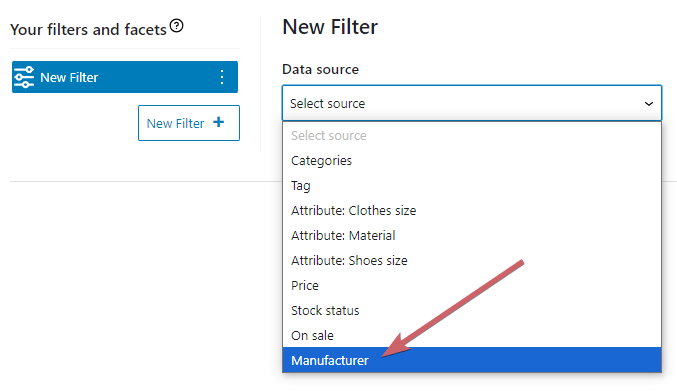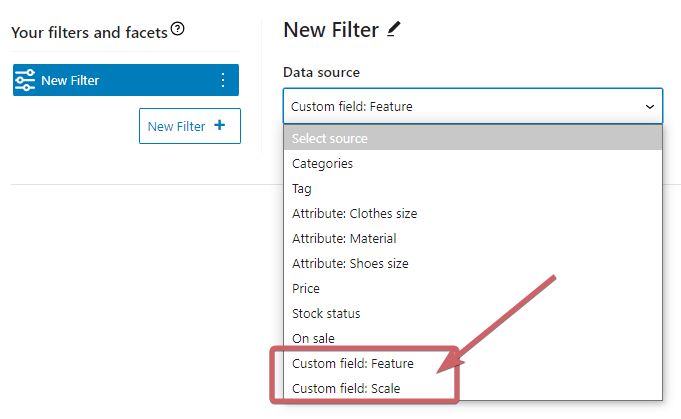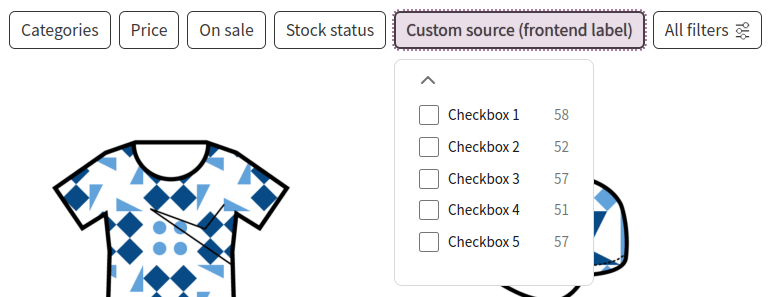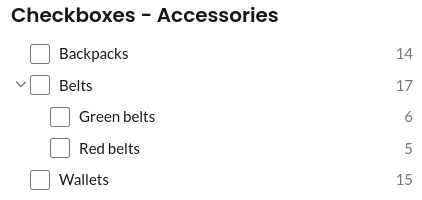When creating filters in the builder, the first step is to choose the data source. By default, FiboFilters add basic WooCommerce data to the source list, such as:
- categories
- tags
- attributes
- price
- stock status
- ‘On sale’ information
Plugin integrations can add new records to the source list. For example, the ACF integration adds custom fields related to products as a new data source. Another example is the ‘Brands’ value added to the sources.
However, some sources, such as taxonomies or custom fields (aside from those mentioned before) can’t be added automatically. To add them to the list, use these PHP snippets.
FiboFilters also introduces a powerful feature called computed filters, which allows you to filter products by virtually anything. Scroll down to “Computed filters” to read more about it.
Table of Contents
- Support for custom taxonomies
- Support for custom fields
- Computed filters
Support for custom taxonomies
Let’s assume that a new taxonomy, “Manufacturer”, has been registered. For this taxonomy to be added to the “Data source” list, you need to use this PHP snippet:
add_filter(
'fibofilters/filters/custom_sources/taxonomies',
function ( $taxonomies ) {
$taxonomies[] = [
'label' => 'Manufacturer',
'taxonomy' => 'manufacturer',
];
return $taxonomies;
}
);
ⓘLearn how to add this snippet to your WordPress.
If the snippet is inserted correctly, a new position will be added to the “Data source” list: “Manufacturer”.

Support for custom fields
Every custom field can be set as a filter’s source data. However, these fields must be first registered – this process is not done automatically. Our integrations with third-party plugins, such as Advanced Custom Fields, are the exception. In this case, custom fields will be immediately selectable as a data source.
To make any custom field selectable from the Data source dropdown, you need to register them with this PHP snippet. Let’s assume that two custom fields were created – “Feature” and “Scale”. Their values are saved in the postmeta table, where the meta_key s are feature and scale, respectively.
add_filter(
'fibofilters/filters/custom_sources/custom_fields',
function ( $custom_fields ) {
$custom_fields[] = [
'field_slug' => 'feature', // meta_key
'label' => 'Custom field: Feature',
'label_front' => 'Product Feature',
];
$custom_fields[] = [
'field_slug' => 'scale', // meta_key
'label' => 'Custom field: Scale',
'label_front' => 'Product Scale',
];
return $custom_fields;
}
);
ⓘLearn how to add this snippet to your WordPress.
If the snippet is inserted correctly, two new positions will be added to the “Data source” list: “Custom field: Feature” and “Custom field: Scale”.

Computed filters
FiboFilters introduces a new feature called computed filters which allows you to define dynamic, code-driven filter sources – meaning you can filter products by virtually anything.
To create a computed filter, follow these three steps:
- Register the computed data source via code.
- Create a filter in the filter builder.
- Rebuild the filter index.
The following example will show you how to create a checkbox filter with a random number (1–5) for each product.
Step 1: Register the custom data source via code.
To register the computed data source, add the following code to your website:
add_filter( 'fibofilters/filters/custom_sources/computed', function ( $sources ) {
$sources[] = [
'label' => 'Custom source (backend label)', // Backend label in filter builder
'label_front' => 'Custom source (frontend label)', // Front-end label
'computed' => 'random-checkboxes', // Unique identifier
'type' => 'checkboxes', // Filter type
'callback' => function ( $product_id, $parent_id ) {
return 'Checkbox ' . wp_rand( 1, 5 );
},
];
return $sources;
} );
ⓘLearn how to add this snippet to your WordPress.
Parameters:
label: backend label (shown in filter builder)label_front: front-end display labelcomputed: unique filter identifiertype:checkboxes,buttons,radio,range,toggle,selectorcolorcallback: a callback function that returns filter values for each product. This function is called by FiboFilters during indexing. Any change to this function requires an index rebuild.
Callback parameters:
$product_id: ID of product being indexed$parent_id: parent product ID (for variable products) or null for simple products
Callback return formats vary by filter type:
select/checkboxes:- scalar (a single value of any type), eg.
'blue',1 - array of scalars, eg.
['blue', 'green'],[1, 2, 3] - hierarchical array (must include the whole hierarchy and not only a part of it), eg.
- scalar (a single value of any type), eg.
[ [ 'value' => '1', 'label' => 'Value 1', 'label_url' => 'value-1', 'parent_value' => '0', ], [ 'value' => '2', 'label' => 'Value 2', 'label_url' => 'value-2', 'parent_value' => '1', ], [ 'value' => '3', 'label' => 'Value 3', 'label_url' => 'value-3', 'parent_value' => '2', ], ]
buttons/radio:- scalar
- array of scalars
range: numeric value (eg.1,1.5). The numeric value can be also written as a string, eg.'1','1.5'toggle: an array where the first value is a boolean positive value ('1','yes','true','on') and the second value is a label, eg.[ '1' , 'In stock' ],[ 'yes' , 'In stock' ]color:- string, eg.
'blue' - array of strings, eg.
['Red', 'Green']or[ '#ff0000', '#00ff00', '#0000ff' ] - an array of arrays where the first element is a color and the second a label, eg.
[ [ '#ff0000', 'Red'] , [ '#00ff00', 'Green' ], [ '#0000ff', 'Blue' ] ]
or[ [ '#ff0000', 'Red'] ]
- string, eg.
Step 2: Create a filter in the filter builder.
The next step is to create a filter from the computed data source. Go to WooCommerce > FiboFilters > Filters, click “New Filter +” and select the newly-created source from the dropdown:

Step 3: Rebuild the index in the “Indexer” tab.
Once these three steps are completed, you will see the new filter in the front-end:

Examples
Stock status toggle based on two custom fields
add_filter( 'fibofilters/filters/custom_sources/computed', function ( $sources ) {
$sources[] = [
'label' => 'Custom stock status',
'label_front' => 'Custom stock status',
'computed' => 'custom_stock_status',
'type' => 'toggle',
'callback' => function ( $product_id, $parent_id ) {
$post_id = ! empty( $parent_id ) ? $parent_id : $product_id;
$store1 = get_post_meta( $post_id, 'store1', true );
$store2 = get_post_meta( $post_id, 'store2', true );
return $store1 === '1' && $store2 === '1' ? [ '1', 'In Stock' ] : '';
},
];
return $sources;
} );
ⓘLearn how to add this snippet to your WordPress.
Select with random values
add_filter( 'fibofilters/filters/custom_sources/computed', function ( $sources ) {
$sources[] = [
'label' => 'Select with random numbers',
'label_front' => 'Select with random numbers',
'computed' => 'select',
'type' => 'select',
'callback' => function ( $product_id, $parent_id ) {
return 'Select ' . wp_rand( 10, 15 );
},
];
return $sources;
} );
ⓘLearn how to add this snippet to your WordPress.
Toggle with products whose names start with a vowel
add_filter( 'fibofilters/filters/custom_sources/computed', function ( $sources ) {
$sources[] = [
'label' => 'The product name begins with a vowel',
'label_front' => 'The product name begins with a vowel',
'computed' => 'vowel-start',
'type' => 'toggle',
'callback' => function ( $product_id, $parent_id ) {
$product = wc_get_product( ! empty( $parent_id ) ? $parent_id : $product_id );
$title = $product->get_title();
$first_letter = mb_substr( $title, 0, 1 );
if ( in_array( mb_strtolower( $first_letter ), [ 'a', 'e', 'i', 'o', 'u', 'y' ], true ) ) {
return [ 'yes', 'Starts with a vowel' ];
}
return '';
},
];
return $sources;
} );
ⓘLearn how to add this snippet to your WordPress.
Range with the product name length
add_filter( 'fibofilters/filters/custom_sources/computed', function ( $sources ) {
$sources[] = [
'label' => 'Name length',
'label_front' => 'Name length',
'computed' => 'name-length',
'type' => 'range',
'callback' => function ( $product_id, $parent_id ) {
$product = wc_get_product( ! empty( $parent_id ) ? $parent_id : $product_id );
$title = $product->get_title();
return strlen( $title );
},
];
return $sources;
} );
ⓘLearn how to add this snippet to your WordPress.
Radio with random values
add_filter( 'fibofilters/filters/custom_sources/computed', function ( $sources ) {
$sources[] = [
'label' => 'Radio with random numbers',
'label_front' => 'Radio with random numbers',
'computed' => 'radio',
'type' => 'radio',
'callback' => function ( $product_id, $parent_id ) {
return 'Radio ' . wp_rand( 1, 5 );
},
];
return $sources;
} );
ⓘLearn how to add this snippet to your WordPress.
Buttons with random numbers
add_filter( 'fibofilters/filters/custom_sources/computed', function ( $sources ) {
$sources[] = [
'label' => 'Buttons with random numbers',
'label_front' => 'Buttons with random numbers',
'computed' => 'buttons',
'type' => 'buttons',
'callback' => function ( $product_id, $parent_id ) {
return 'Button ' . wp_rand( 1, 5 );
},
];
return $sources;
} );
ⓘLearn how to add this snippet to your WordPress.
One filter from multiple custom fields
add_filter( 'fibofilters/filters/custom_sources/computed', function ( $sources ) {
$sources[] = [
'label' => 'Availability',
'label_front' => 'Availability',
'computed' => 'availability-chbx',
'type' => 'checkboxes',
'callback' => function ( $product_id, $parent_id ) {
$availability = array();
if ( ff_get_post_meta( $product_id, '_is_cracow_available' ) ) {
$availability[] = "Kraków";
}
if ( ff_get_post_meta( $product_id, '_is_warsaw_available' ) ) {
$availability[] = "Warszawa";
}
if ( ff_get_post_meta( $product_id, '_is_gdansk_available' ) ) {
$availability[] = "Gdańsk";
}
return $availability;
},
];
return $sources;
} );
function ff_get_post_meta( $product_id, $meta_key ) {
$meta_value = get_post_meta( $product_id, $meta_key, true );
if ( ! empty( $meta_value ) && 1 == $meta_value ) {
return true;
}
return false;
}
ⓘLearn how to add this snippet to your WordPress.
Parcel locker size
Creates a filter with parcel locker sizes (‘Size XS’, ‘Size A’, ‘Size B’, ‘Size C’ or ‘Out of scale’) calculated for each product based on its dimensions and weight.
add_filter( 'fibofilters/filters/custom_sources/computed', function ( $sources ) {
$sources[] = [
'label' => 'Parcel Locker shipment',
'label_front' => 'Parcel Locker shipment',
'computed' => 'checkboxes',
'type' => 'checkboxes',
'callback' => function ( $product_id ) {
$parcel_locker_shipment = [
'Size XS (4 × 23 × 40 cm)' => [ 4, 23, 40, 3 ], // height, width, length, weight.
'Size A (8 × 38 × 64 cm)' => [ 8, 38, 64, 25 ],
'Size B (19 × 38 × 64 cm)' => [ 19, 38, 64, 25 ],
'Size C (41 × 38 × 64 cm)' => [ 41, 38, 64, 25 ],
];
$product = wc_get_product( $product_id );
$product_size = [
$product->get_height(),
$product->get_width(),
$product->get_length(),
$product->get_weight(),
];
foreach ( $parcel_locker_shipment as $label => $matrix ) {
$fit = true;
foreach ( $matrix as $i => $value ) {
if ( $product_size[ $i ] >= $value ) {
$fit = false;
break;
}
}
if ( $fit ) {
return $label;
}
}
return 'Out of scale';
},
];
return $sources;
} );
ⓘLearn how to add this snippet to your WordPress.
Custom attributes
Creates a filter from custom attributes defined in the product editor. In this example, the attributes are stored as a string with values separated with a dash (-), eg. AA 11 - BB 22 - CC 33.
add_filter( 'fibofilters/filters/custom_sources/computed', function ( $sources ) {
$sources[] = [
'label' => 'Motortype (custom)',
'label_front' => 'Motortype',
'computed' => 'motortype-checkboxes',
'type' => 'checkboxes',
'callback' => function ( $product_id, $parent_id ) {
$product = wc_get_product( $product_id );
$attr = $product->get_attribute( $attribute );
$attr = explode( ' - ', $attr );
$attr = array_unique( $attr );
return $attr;
},
];
return $sources;
} );
ⓘLearn how to add this snippet to your WordPress.
Support for hierarchical taxonomies
FiboFilters introduces two helper hooks that make it easy to create custom hierarchical filters:
fibofilters/indexer/helper/get_ancestor_tree_as_values: returns ancestor terms for a given termfibofilters/indexer/helper/get_children_values: returns child terms for a given term
Using these two hooks, you can create a filter based on a hierarchical taxonomy (like product categories), removing some terms and keeping the hierarchy.
Let’s assume that your product category tree looks like this:
- Accessories
- Backpacks
- Belts
- Green belts
- Red belts
- Wallets
- Caps
- T-shirts
- Trousers
Now you want to create a filter that consists only of children of the “Accessories” category. You can achieve it with the following code:
add_filter( 'fibofilters/filters/custom_sources/computed', function ( $sources ) {
$sources[] = [
'label' => 'Checkboxes - Accessories',
'label_front' => 'Checkboxes - Accessories',
'computed' => 'checkboxes-accessories',
'type' => 'checkboxes',
'callback' => function ( $product_id, $parent_id ) {
$object_id = ! empty( $parent_id ) ? $parent_id : $product_id;
$object_terms = wp_get_object_terms( $object_id, 'product_cat' );
// Get tree of ancestor categories for the product (including the product's category).
$values = apply_filters( 'fibofilters/indexer/helper/get_ancestor_tree_as_values', [], $object_terms );
// Get only children of Accessories category (ID: 205).
return apply_filters( 'fibofilters/indexer/helper/get_children_values', $values, 205 );
},
];
return $sources;
} );
ⓘLearn how to add this snippet to your WordPress.
This is what it looks like on the front-end:
